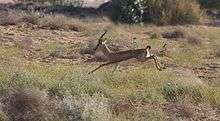Chinkara
| Chinkara | |
|---|---|
 | |
| Chinkara in the Gir Forest, Gujarat | |
| Scientific classification | |
| Kingdom: | Animalia |
| Phylum: | Chordata |
| Class: | Mammalia |
| Order: | Artiodactyla |
| Family: | Bovidae |
| Subfamily: | Antilopinae |
| Tribe: | Antilopini |
| Genus: | Gazella |
| Species: | G. bennettii |
| Binomial name | |
| Gazella bennettii (Sykes, 1831) | |
The chinkara, also known as the Indian gazelle, is a gazelle species native to Iran, Pakistan and India.[1]
Characteristics

It stands at 65 cm (26 in) tall and weighs about 23 kg (51 lb). It has a reddish-buff summer coat with smooth, glossy fur. In winter, the white belly and throat fur is in greater contrast. The sides of the face have dark chestnut stripes from the corner of the eye to the muzzle, bordered by white stripes. Its horns reach over 39 cm (15 in).[2]
Distribution and habitat

Chinkara live in arid plains and hills, deserts, dry scrub and light forests. They inhabit more than 80 protected areas in India. In Pakistan, they range up to elevations of 1,500 m (4,900 ft). In Iran, they inhabit the Kavir National Park.[3]
In 2001, the Indian chinkara population was estimated at 100,000 with 80,000 living in the Thar Desert. The population in Pakistan is scattered, and has been severely reduced by hunting. Also in Iran, the population is fragmented. In Afghanistan, chinkaras are probably very rare.[3]
Ecology
Chinkaras are shy and avoid human habitation. They can go without water for long periods and can get sufficient fluids from plants and dew. Although most are seen alone, they can sometimes be spotted in groups of up to four animals. They share their habitat with several other herbivores, such as nilgai, blackbuck, chausingha, wild goats, and wild pigs.
Chinkaras mate once a year. Males compete for access to females.
Chinkaras are preyed upon by leopards, Bengal tigers, and dholes. The chinkara was a common prey of the Asiatic cheetah in India alongside blackbucks. Outside protected areas they may be attacked by pariah dogs, and both wolves and golden jackals are also known to hunt them.
Threats and conservation
The chinkara is threatened by extensive hunting for meat and trophies in Afghanistan, Iran and Pakistan. Other threats include habitat loss to agricultural and industrial expansion. The status in these countries is unclear; around 1,300 individuals occur in Iran. However, the situation in India is not so grim; in 2001, populations were estimated at over one million in the country (nearly 80,000 occur in the Thar desert in northwestern India), with a stable population trend. In 1994, it was categorised as Vulnerable by the International Union for Conservation of Nature and Natural Resources (IUCN). The situation has looked up since then, and the classification has been changed to Least Concern in 2003.[1][4]
The chinkara occurs in over 80 protected areas in India.[4] In 1993, a controversy erupted when the Gujarat government issued a decree to denotify the Narayan Sarovar Sanctuary, that contains a small population of chinkara, to allow mining of lignite, limestone, bentonite and bauxite inside the sanctuary. This was, however, rejected by the Gujarat High Court, and the sanctuary was restored to its earlier limits.[4][5] In January 2016, the Karnataka government issued a notification to establish a sanctuary especially for chinkara in the Yadahalli village in the Bagalkot district of the state. This region shelters a major population of chinkara.[6] The chinkara is protected in nine areas of Iran and five of Pakistan.[1]
References
- 1 2 3 4 Mallon, D. P. (2008). "Gazella bennettii". IUCN Red List of Threatened Species. Version 2014.3. International Union for Conservation of Nature.
- ↑ Prater, S. H. (1971). The Book of Indian Animals. Oxford University Press, 2005 reprint.
- 1 2 Mallon, D. P. and S. C. Kingswood (eds.) (2001). Antelopes. Part 4: North Africa, the Middle East, and Asia. Global Survey and Regional Action Plans, IUCN, Gland, Switzerland.
- 1 2 3 Mallon, D.P.; Kingswood, S.C.; East, R.D. (2001). Antelopes : Global Survey and Regional Action Plans. Gland, Switzerland: IUCN. p. 185. ISBN 9782831705941.
- ↑ Kumar, S. (26 August 1995). "Mining digs deep into India's wildlife refuges". New Scientist. Retrieved 12 March 2016.
- ↑ Prabhu, N. (1 January 2016). "State gets first chinkara sanctuary". The Hindu. Retrieved 12 March 2016.
